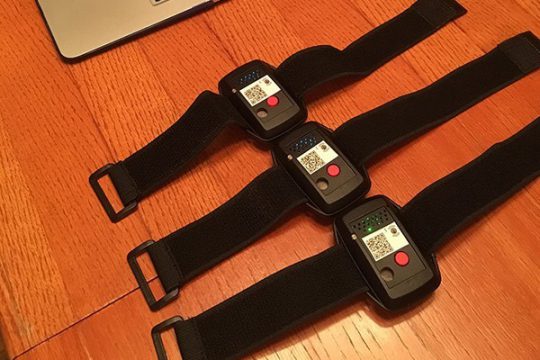The MākuSafe® Difference: Part 5, Other Insurer Benefits
August 6, 2019
This piece is the final installment of a five-part series highlighting the impact of MākuSafe®. Read about its benefits for workers, safety managers, industrial organizations, and loss prevention/workers’ compensation departments on the blog.
In the previous article in this series, we looked at why MākuSafe® is valuable for workers’ compensation and loss prevention departments — the obvious beneficiaries of a device that helps improve workplace safety. The predictive data and near miss indicators that the system provides enables these departments to engage with and influence safety leadership to increase effectiveness within the policyholder organization.
MākuSafe® data will likely contribute to reduced loss ratios, and may have an additional positive impact by reducing expenses. Loss control departments typically have one point of contact with policyholders each year — often for policy renewal or if there are repeated issues. But renewal visits don’t always allow sufficient time for discussing hazards and mitigation solutions. With the information from MākuSafe® at hand, insurance loss control professionals can reach more policyholders more often right from their desks. It’s a proactive way to mitigate risk and lets these professionals know exactly where to focus their attention.
With a focus on reducing claims and losses, the system is also helpful for other aspects of business operations for insurance carriers, agents, and brokers.
Benefits for Actuarial Departments
The actuaries who model risk and then price it for workers’ compensation insurance have, historically, used predictive modeling to calculate risk — but rarely, if ever, has it been possible for them to access real-time leading indicators of risk in industrial environments. The use of leading indicator data can help actuaries model risk more accurately by painting a more realistic picture of the risk that workers are facing.
Actuaries also establish reserves to cover the cost of potential claims, and they use historical data to calculate the amount needed. But if anticipated claims are lower, it only makes sense that reserves will eventually be lowered, too. For large insurers, this could mean millions of dollars in cash flow freed up for other purposes.
In many instances, actuaries purchase data to build their risk models. Of course, it’s historical data that is based on lagging indicators. MākuSafe® eliminates the need for outside data and delivers leading indicators to risk gathered from on individual workers — data that isn’t available for purchase or from anywhere else. By harnessing machine learning and artificial intelligence, the system focuses on the type of predictive data that is in demand in the industry, but that many actuaries don’t yet know exists.
Benefits for Underwriting
Underwriting is a critical piece of the insurance puzzle — it’s where the insurance company determines what kind of risk they want to take on, how they want to define it, and how it should be priced. But the reality is that these determinations are often made based on past incidents and anecdotal information. MākuSafe® allows underwriters to better understand the actual risk facing policyholder organizations.
MākuSafe® can also be helpful when it comes to entering new markets. Being able to get an accurate idea of risk levels in new industries might allow insurers to take on markets that were once considered too high risk for coverage, and enables underwriters to ensure they target the policy pricing properly.
Benefits for Claims
Between investigations and paperwork, processing claims can be an arduous and time-consuming task. MākuSafe® reduces paperwork and streamlines the claims process, offering hard evidence to substantiate and expedite claims and pre-populating forms with accurate data to ensure it’s reported in a timely way.
Since the data shows exactly where and when incidents happened (or didn’t), little in the way of investigation is necessary. The reliable, complete data that MākuSafe® provides up front helps reduce the occurrence of long-tail claims and ensures that claims are paid out and closed quickly. It can also help reduce the potential for fraud.
Future Opportunities
For insurance companies looking to open up into new markets and move into niches that aren’t currently being filled, the data that MākuSafe® provides can help identify specific risk areas to ensure that policies are underwritten accurately, priced correctly, and marketed to sell. It’s a reliable, efficient way to explore and capitalize on new business opportunities.
It can also offer insurers a competitive advantage in an industry with a significant amount of competition. The data that MākuSafe® provides isn’t available anywhere else, and insurers that use the system add greater value for their policyholders by helping them increase productivity, ensure quality, and more.
Long term, this sort of predictive modeling may also have a greater impact on insurance areas we haven’t yet considered. Might it be possible to write better life coverage, for example, once you have a picture of the hazards and risk in someone’s workplace or industry? If a business is using this technology to make the workplace safer and more efficient, why couldn’t the information it collects be applied to assess the actual level of risk that someone is facing?
There are, theoretically, a whole lot of different ways for MākuSafe® to completely disrupt the traditional way of working. And as the EHS and insurance industries shift and adapt to changing realities, so, too, will the way that MākuSafe® can be applied to them.
About MākuSafe
MākuSafe® is an Iowa-based software as a service (SaaS), data, and analytics company working to improve employee health, safety, and productivity, while reducing workers’ compensation claims and mitigating workplace risks. Our proprietary wearable technology gathers real-time environmental and motion data from workers and delivers it to the cloud platform, which uses machine learning to identify and notify safety leaders about high-risk trends in the facility. The portal also auto-records near-miss leading indicators, proactively targets loss control resources to specific conditions and occurrences, and streamlines compliance reporting.





